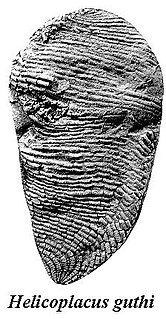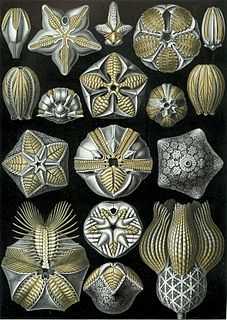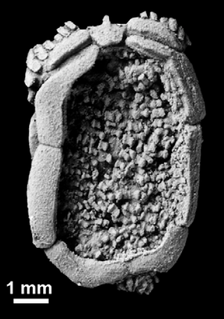
A chordate is an animal of the phylum Chordata. All chordates possess five synapomorphies, or primary characteristics, at some point during their larval or adulthood stages that distinguish them from all other taxa. These five synapomorphies include a notochord, dorsal hollow nerve cord, endostyle or thyroid, pharyngeal slits, and a post-anal tail. The name “chordate” comes from the first of these synapomorphies, the notochord, which plays a significant role in chordate structure and movement. Chordates are also bilaterally symmetric, have a coelom, possess a circulatory system, and exhibit metameric segmentation.

Edrioasteroidea is an extinct class of echinoderms. The living animal would have resembled a pentamerously symmetrical disc or cushion. They were obligate encrusters and attached themselves to inorganic or biologic hard substrates. A 507 million years old species, Totiglobus spencensis, is actually the first known echinoderm adapted to live on a hard surface after the soft microbial mats that covered the seafloor were destroyed in the Cambrian substrate revolution.

Helicoplacoidea is an extinct class within the Echinodermata. All known taxa were discovered in sediments dating back to the Cambrian.

Blastozoa is a subphylum of extinct animals belonging to Phylum Echinodermata. This subphylum is characterized by the presence of specialized respiratory structures and brachiole plates used for feeding. This subphylum ranged from the Cambrian to the Permian.

The Eocrinoidea are an extinct class of echinoderms that lived between the Early Cambrian and Late Silurian periods. They are the earliest known group of stalked, arm-bearing echinoderms, and were the most common echinoderms during the Cambrian.

Camptostroma roddyi is an extinct echinoderm from the Bonnia-Olenellus Zone the Early Cambrian Kinzers Formation near York and Lancaster, Southeastern Pennsylvania. In life, it would have resembled a cupcake, with the axial skeleton forming a star pattern on the upper surface. It was originally thought, on the basis of its medusoid shape, to be a jellyfish-like organism, but the fossils themselves clearly rule out the possibility of a gelatinous body - the stereom plates are clearly preserved and possess the calcitic cleavage pattern diagnostic of echinoderms. It has been placed in a class of basal echinoderms, the Edrioasteroids.

Lichenoides is an extinct genus of echinoderms that lived during the Middle Cambrian in what is today the Czech Republic.
Kailidiscus is an extinct genus of echinoderms which existed in what is now China during the Middle Cambrian period. It was named by Yuanlong Zhao, Colin D. Sumrall, Ronald L. Parsley and Jin Peng in 2010, and the type and only species is Kailidiscus chinensis.

The cambroernids are an unranked clade of deuterosome animals. They include a number of early Paleozoic genera whose affinities with other animals, living or extinct, have been uncertain. This includes Herpetogaster and Phlogites, as well as the eldoniids. Cambroernids are defined by a set of common features including at least one pair of bifurcated or divided oral tentacles, and a large stomach and narrower intestine enclosed together in a coiled sac. The proposed evolutionary transformation is from more mobile forms living in the water column to less mobile forms living on the sea floor. Herpetogaster shows a clockwise-curved body attached to the substrate with a narrow mobile stolon, the caylx of Phlogites would be such a body fused into a complete circle, permanently attached to the substrate by a thick stalk, and eldoniids are a flattened form in which the stolon has been lost, resulting in a disc-shaped external form with a large curved stomach on one side. These translations of form are parallel to those seen in echinoderms. Relationships to tentaculate lophotrochozoans are considered and rejected, with the balance of evidence currently supporting the clade as either stem echinoderms, stem hemichordates, or stem ambulacrarians (echinoderms+hemichordates).
Dibrachicystis is an extinct genus of rhombiferan echinoderm from the early Middle Cambrian. It is a stalked echinoderm within the family Dibrachicystidae which lived in what is now northernmost Iberian Chains, northern Spain. It is known from the holotype MPZ2009/1230 and from the paratypes MPZ2011/2–6. It was found in the uppermost part of the Murero Formation at Purujosa, Moncayo Natural Park, dating to the Lower Languedocian and referred to the Solenopleuropsis thorali Zone. It was first named by Samuel Zamora and A. B. Smith in 2011 and the type species is Dibrachicystis purujoensis.
Vizcainoia is an extinct genus of rhombiferan echinoderms from the early Middle Cambrian. It is a stalked echinoderm within the family Dibrachicystidae which lived in what is now France and Spain.

Stereom is a calcium carbonate material that makes up the internal skeletons found in all echinoderms, both living and fossilized forms. It is a sponge-like porous structure which, in a sea urchin may be 50% by volume living cells, and the rest being a matrix of calcite crystals. The size of openings in stereom varies in different species and in different places within the same organism. When an echinoderm becomes a fossil, microscopic examination is used to reveal the structure and such examination is often an important tool to classify the fossil as an echinoderm or related creature.
Cotyledion tylodes is an extinct, stalked filter-feeder known from the Chengjiang lagerstatten. The living animal reached a couple of centimetres in height, and bore a loose scleritome of ovoid sclerites. Its interpretation has been controversial, and it has been previously identified as a carpoid echinoderm, or as a stem group echinoderm. C. tylodes is now classified as a stem group entoprocta based on new fossils that clearly show a U-shaped gut and a crown of tentacles.

Cincta is an extinct class of echinoderms that lived only in the Middle Cambrian epoch. Homostelea is a junior synonym. The classification of cinctans is controversial, but they are probably part of the echinoderm stem group.
Cambraster is an extinct genus of edrioasteroids with species that existed during the Cambrian.
Olivooides is an extinct, sphere-shaped microfossil from Cambrian strata. Fossils are currently known only from China. Olivooides was approximately 600‐870 μm in diameter. It was an egg with a large yolk content. Fossils from Shaanxi, China can be found in the cleavage, gastrulation, organogenesis, cuticularization, pre‐hatching, post‐hatching and subsequent growth stages of development. This fossil is a result of soft-bodied preservation. Olivooides has pentaradial symmetry and is usually preserved by calcium phosphate endocast. The internal structure is rarely preserved. It has no larval stage, so it likely had a quick and direct development.

Soluta is an extinct class of echinoderms that lived from the Middle Cambrian to the Early Devonian. The class is also known by its junior synonym Homoiostelea. Soluta is one of the four "carpoid" classes, alongside Ctenocystoidea, Cincta, and Stylophora, which made up the obsolete subphylum Homalozoa. Solutes were asymmetric animals with a stereom skeleton and two appendages, an arm extending anteriorly and a posterior appendage called a homoiostele.

Ctenocystoidea is an extinct clade of echinoderms, which lived during the Cambrian and Ordovician periods. Unlike other echinoderms, ctenocystoids had bilateral symmetry, or were only very slightly asymmetrical. They are believed to be one of the earliest-diverging branches of echinoderms, with their bilateral symmetry a trait shared with other deuterostomes. Ctenocystoids were once classified in the taxon Homalozoa, also known as Carpoidea, alongside cinctans, solutes, and stylophorans. Homalozoa is now recognized as a polyphyletic group of echinoderms without radial symmetry. Ctenocystoids were geographically widespread during the Middle Cambrian, with one species surviving into the Late Ordovician.

Yanjiahella biscarpa is an extinct species of Early Cambrian deuterostome which may represent the earliest stem group echinoderms.
Dianchicystis is an basal extinct genus of vetulocystids. It was found in Jianshan, near Haikou, Qiongzhusi Fm..













